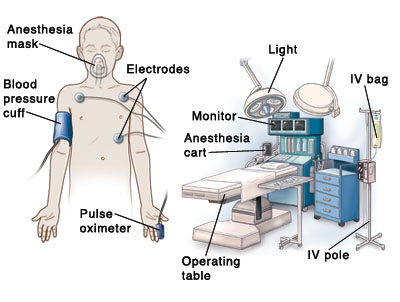When Your Child Needs Surgery: The Operating Room and Staff
When Your Child Needs Surgery: The Operating Room and Staff
Your child is having surgery. Surgery takes place in an operating room in a hospital or a surgery center. Help your child prepare by learning more about the operating room staff and the kind of equipment your child might see. Knowing what to expect can help you and your child feel more comfortable about surgery.
Who are the operating room staff?
Members of your child’s operating/surgery team include the following people:
The surgeon is the doctor who does the surgery.
The anesthesiologist is the doctor trained to give anesthesia. There are several types of anesthesia, but general anesthesia is the most common type used for children. This medicine causes your child to fall asleep and not feel pain during surgery.
The anesthesiologist may be assisted by a nurse anesthetist (or anesthesia assistant) who is also trained to give anesthesia. An anesthesia resident (trainee) may also be present to help with your child's care.
Nurses take care of your child and help the surgeon with various tasks.
What do the operating staff wear?
The operating staff wear clothing called “scrubs” that look like pajamas.
During surgery, operating staff wear masks over their mouths and noses, and hats on their heads. They also wear surgery gloves on their hands. This helps keep everything clean and sterile.
What is inside the operating room?
Following is a list of equipment that your child may see in the operating room.
Your child will lie on an operating table during surgery. This is a narrow bed that can be raised or lowered. A strap may also be used to help keep your child safely on the operating table.
Bright lights over the operating table help operating staff see better during surgery.
An anesthesia cart holds equipment that the anesthesiologist or nurse anesthetist uses during surgery. Monitors help keep track of your child’s vital signs, such as blood pressure, heart rate, and breathing.
Electrodes (sticky pads or stickers) are placed on your child’s body to keep track of your child’s heart rate.
A pulse oximeter measures the oxygen level in your child’s blood. It may look like a bandage or a soft clip. It is placed around a finger or toe and has a small red light.
A blood pressure cuff is wrapped around your child’s arm or leg. It is connected to a blood pressure machine. This machine checks your child’s blood pressure every few minutes during surgery.
An intravenous (IV) line is a thin flexible tube placed in a vein. It is used to deliver fluids and medicine to your child during surgery. The fluids flow through an IV from a bag that hangs on an IV pole.
Updated:
March 27, 2017
Sources:
Block, FE., Operating Room Design Manual (2012); 50-54
Reviewed By:
Adler, Liora, C., MD,Dozier, Tennille, RN, BSN, RDMS,Image reviewed by StayWell medical illustration team.
